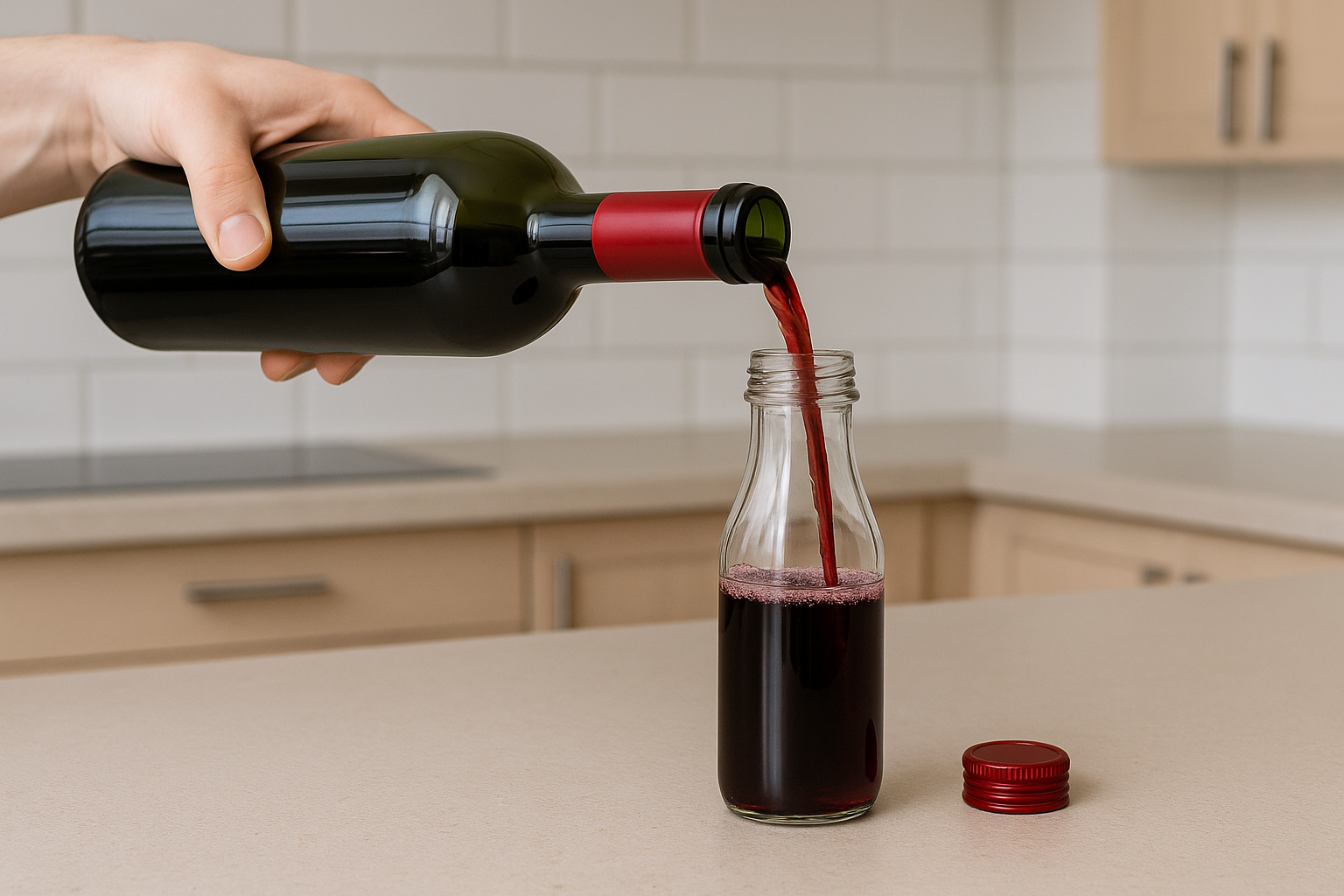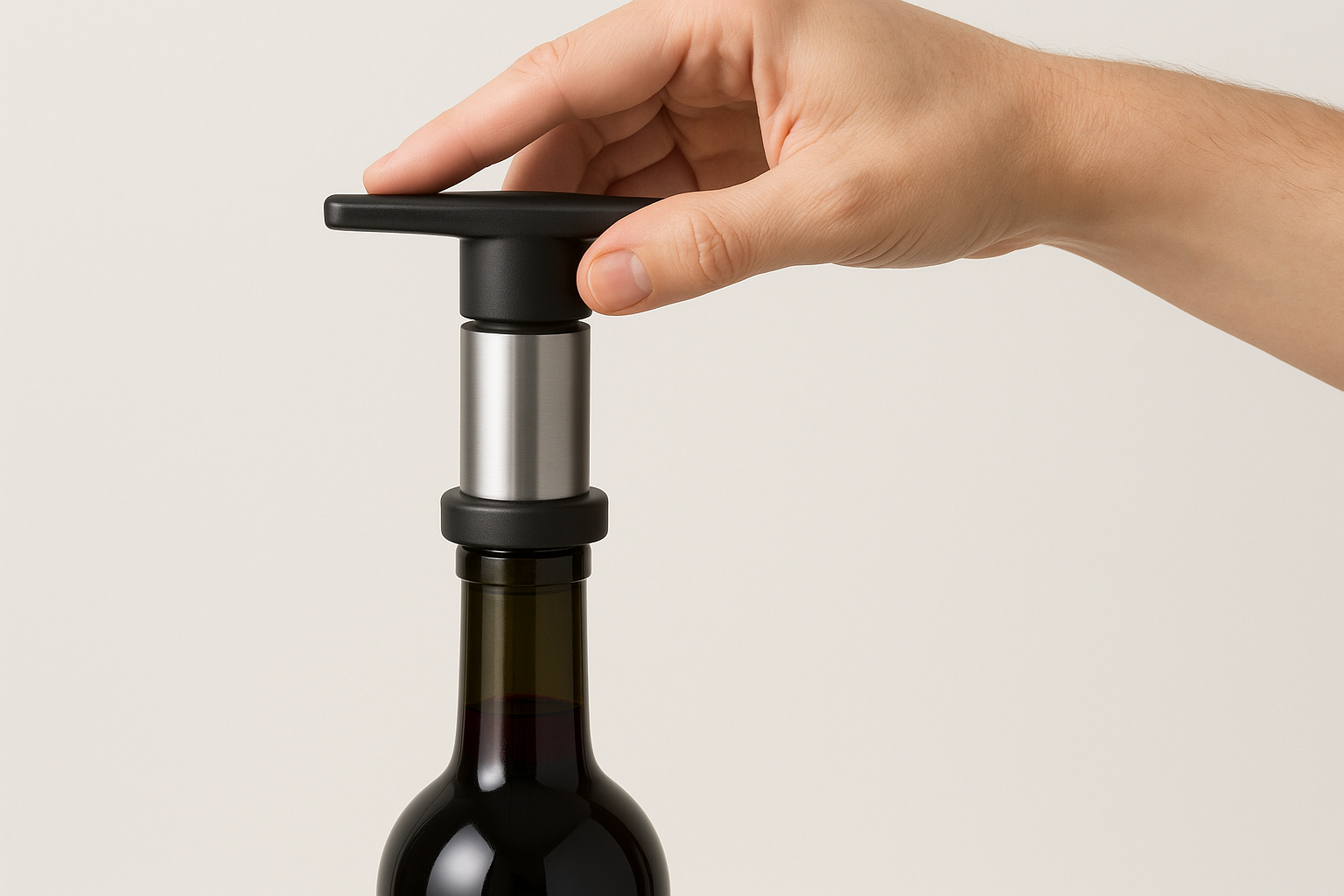How to Store Opened Wine So It Tastes Great Tomorrow
Learn simple, effective methods to store opened wine, from re-corking to vacuum pumps, so it still tastes great tomorrow.
12 min read
It’s a familiar story. You decide to open that lovely bottle of Cabernet Sauvignon you’ve been saving. You pour a glass, let it breathe, and take that first perfect sip. It’s everything you hoped for. Rich, smooth, and delicious. You have a second glass with dinner, and it’s the perfect end to a long day.
But then you look at the bottle. It’s still half-full.
A little voice in your head starts to whisper. "What do I do with the rest? If I leave it on the counter, it’s going to taste like sour grape juice tomorrow. I don’t want to waste it. It was a good bottle!"
This moment is the reason so many of us hesitate to open a bottle of wine on a Tuesday night. We’re afraid of wasting it. The fear is real. We’ve all been there: you pour a glass the next day, and that beautiful wine now tastes flat, sharp, and sadly like vinegar.
But what if I told you there are simple, almost foolproof ways to keep your opened wine tasting great for days? It’s not magic, and you don’t need a lot of fancy equipment. You just need to understand your wine’s one true enemy.
The Real Reason Your Wine Goes Bad
The number one enemy of your opened wine is oxygen.
Think about what happens when you slice an apple and leave it on the counter. It starts to turn brown, right? That’s a process called oxidation. The same thing happens to your wine, but instead of turning brown, it loses its fresh, fruity flavors and starts to taste nutty or sour.
When you first open a bottle, a little bit of air is a good thing. It helps the wine "open up," releasing all its wonderful smells and flavors. But when your wine is exposed to too much oxygen for too long, it starts to break down.
The other enemy is heat. Heat speeds up all chemical reactions, including oxidation. Leaving an opened bottle of wine on your kitchen counter, especially in the summer, is a recipe for disaster.
So, the secret to storing opened wine is simple: reduce its contact with air and keep it cool. That’s it. Every tip and trick that follows is just a different way of achieving those two simple goals.
The Golden Rules: Your Game Plan for Fresh Wine
Let’s get into the practical stuff. Here are the best methods for storing your opened wine, from the super-simple to the super-effective.
Rule #1: Re-Cork It, But Do It Right
This is the most basic method, and it’s better than nothing. As soon as you’ve poured your last glass for the evening, put the cork back in the bottle.
Pro-Tip: Sometimes the cork is hard to get back in. If you look at the cork, one end was inside the bottle (stained with wine) and the other was outside. People often try to put the "dry" side back in, but it’s often wider and can be a struggle. The "wet" side will slide back in much more easily. If the cork is crumbly, a simple rubber wine stopper from the grocery store is a great, cheap investment.
How long will it last? Just re-corking and leaving it on the counter might give you a day, maybe two if you’re lucky. It slows down the process, but there’s still a lot of oxygen trapped in that bottle.
Rule #2: The Fridge is Your Friend (Yes, Even for Red Wine!)
This is the most important rule of all. Once you’ve sealed your bottle, put it in the fridge.
- For White Wine & Rosé: This is a no-brainer. They’re served chilled anyway.
- For Red Wine: This might feel wrong, but trust me, it’s the right move. Remember, heat speeds up oxidation. The cold temperature of the fridge slows that process way, way down. It’s the single best thing you can do to preserve your wine’s flavor.
"But I don't want to drink cold red wine!" you say. Of course not. Just take the bottle out of the fridge about 30-60 minutes before you want to drink it. It will come back up to the perfect temperature on its own. A cold red wine is better than a vinegary red wine every single time.
Rule #3: Give It Less Air to Breathe
This is where we level up. The less air is in the bottle with the wine, the longer it will last. Here are a few ways to do that.
Method A: The Half-Bottle Trick (Low-Tech, High-Effect)
This is my favorite low-tech method because it’s cheap and it works incredibly well. Air is the problem, so get rid of it by moving the wine to a smaller container.
- Get a smaller bottle. You can buy 375ml half-bottles of wine (which come with a handy screw cap) or just find any small, clean glass bottle with an airtight lid. A small mason jar can even work in a pinch.
- Pour the leftover wine from your main bottle into the smaller bottle, filling it all the way to the very top.
- Seal it tightly and pop it in the fridge.
By filling the small bottle to the brim, you’ve left almost no room for oxygen. This simple trick can easily keep your wine tasting fresh for 3 to 5 days.

Method B: Use a Wine Vacuum Pump (Easy and Popular)
You’ve probably seen these gadgets. They come with a special rubber stopper that you put in the bottle. You then place the pump on top and pump it a few times. You’ll feel the resistance build as it sucks the air out of the bottle.
Pros: They are affordable, easy to find, and definitely better than just a cork. They can add a couple of days to your wine’s life.
Cons: They aren’t perfect. They can’t remove all the oxygen, and some wine experts argue that the vacuum can also pull out some of the delicate aroma compounds from the wine, slightly dulling the flavor. But for most everyday wines, they work great.

Method C: Use Inert Gas (The Pro-Level Choice)
If you often drink very nice, expensive wine and want to savor it over a week or more, this is the way to go. This method uses a spray can filled with a safe, harmless gas (usually argon, which is heavier than oxygen).
You simply spray a little bit of the gas into the bottle before putting the cork back in. The heavy gas creates a protective blanket on top of the wine, preventing any oxygen from touching it. Systems like Coravin are a more advanced version of this, using a needle to extract wine without ever removing the cork.
Pros: This is by far the most effective method. It can preserve a wine’s taste for weeks.
Cons: It’s the most expensive option. A can of gas will cost you a bit, but if it saves a $50 bottle of wine, it’s well worth it.
So, How Long Does My Wine Really Last?
Here’s a quick and easy guide. These timelines assume you’ve sealed the bottle properly and stored it in the fridge.
- Sparkling Wine (Champagne, Prosecco): 1–2 days. You need a special sparkling wine stopper to keep the bubbles.
- Light White & Rosé (Pinot Grigio, Sauvignon Blanc): 3–5 days. They will lose some of their vibrant character after the first couple of days.
- Full-Bodied White (Chardonnay, Viognier): 3–5 days. These can sometimes last a bit longer than lighter whites.
- Red Wine (Merlot, Cabernet, Syrah): 3–5 days. Some robust reds even taste a little better on day two as they soften up!
- Boxed Wine: 4–6 weeks. The bag-in-a-box design is actually a brilliant way to store wine, as the bag collapses as you pour, preventing air from getting in.
Don’t Just Store It, Learn From It!
Now that you know how to keep your wine fresh, you can turn this into a fun experiment. How do you really know if the wine still tastes good? By comparing it.
This is where a wine journal app like Vinoh becomes your secret weapon.
When you first open a bottle, take a moment to log it in the app. You can scan the label or enter it manually. Then, add a few tasting notes. What does it smell like? Berries? Oak? Flowers? What does it taste like? Is it sweet, acidic, bold?
The next day, when you pour another glass, open Vinoh and compare.
- Does it still smell as fruity as it did yesterday?
- Has the taste become a little flatter?
- Or has it developed a new, interesting flavor?
By doing this, you’re not just saving your wine; you’re training your palate. You’ll start to notice the subtle changes in wine, and you’ll learn which types of wine hold up best after being opened. It turns a simple glass of wine into a personal tasting adventure.
You can download Vinoh from the App Store and start your own wine journey. It’s the perfect tool to help you remember every bottle and learn what you love.
What If It’s Too Late? Don’t Pour It Down the Drain!
Sometimes, despite our best efforts, a wine is just past its prime for drinking. But that doesn’t mean it’s useless! Here are a few great ways to use up leftover wine:
- Make Red Wine Vinegar: Just leave the bottle out with a cheesecloth over the top. After a few weeks, you’ll have your own homemade vinegar.
- Use It in Cooking: Leftover red wine is fantastic for beef stews, tomato sauces, or pan sauces for steak. Leftover white wine is great for risotto, pasta with clams, or steaming mussels.
- Freeze It: Pour the leftover wine into an ice cube tray. The next time a recipe calls for a splash of wine, you can just pop in a cube.
Need Help Picking the Right Bottle? Ask Soma.
Sometimes the problem isn’t storing the wine, but choosing it. Maybe you’re standing in the wine aisle, and you know you won’t finish a whole bottle this week. What should you buy?
This is another place where the Vinoh app can guide you. Inside the app is an AI assistant called Soma. Soma is designed to be your personal sommelier.

You can ask Soma anything.
- "Soma, I’m making chicken tonight. Can you recommend a good Chardonnay that will last a few days if I don’t finish it?"
- "Hey Soma, are there any good red wines that come in half-bottles?"
- "Which types of wine are best for storing after opening?"
Soma can give you personalized recommendations that take the guesswork out of buying wine, helping you pick the perfect bottle for any occasion, whether you plan to drink it all in one night or savor it over several.
Your Wine, Your Rules
The fear of wasting wine is a thing of the past. You now have a full toolkit of simple, effective strategies to keep your opened wine fresh and delicious.
To recap the magic formula:
- Seal it: Use the cork, a stopper, or a vacuum pump.
- Cool it: Always put opened wine in the fridge (reds included!).
- Reduce Air: For best results, transfer it to a smaller bottle.
So go ahead and open that bottle on a whim. Enjoy a glass tonight, and trust that with these tips, you can enjoy another great-tasting glass tomorrow.
Happy tasting!
